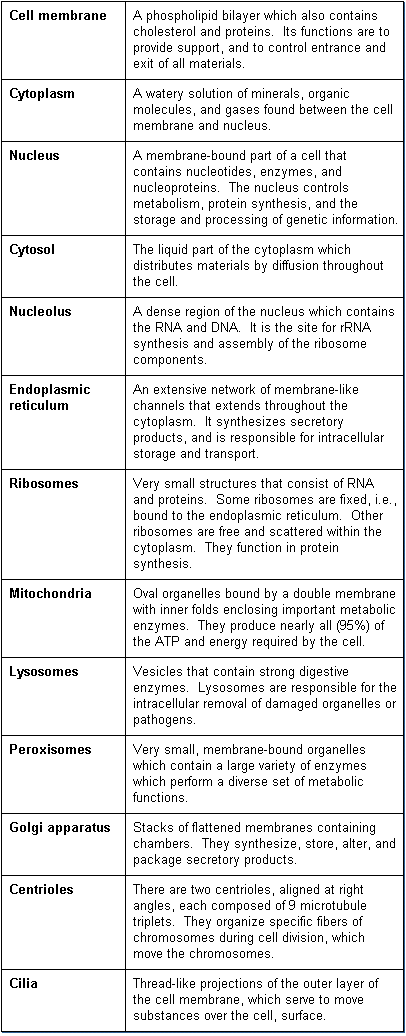|
 |
 |
 |
 |
|
|
|






Cells

Cells are the smallest component of the body that can perform all of the basic life functions. Each cell performs specialized functions and plays a role in the maintenance of homeostasis. While each cell is an independent entity, it is highly affected by damage to neighboring cells. These various cell types combine to form tissues, which are basically collections of specialized cells that perform a relatively limited number of functions specific to that type tissue. The human body is made up of several trillion cells. These cells are of various types, which can differ greatly in size, appearance and function.
While there are approximately 200 types of cells, they all have similar features: cell membrane, cytoplasm, organelles, and nucleus. The only exception is that the mature red blood cell does not contain a nucleus. In ToxTutor II we discussed the structure of the cell membrane and the mechanisms by which chemicals can penetrate or be absorbed into or out of the cell. We did not discuss the other components of the cell. Toxins can injure any of the components of the cell causing cell death or damage and malfunction.
A composite cell is illustrated below to show the various components.
 |
 |
 |
 |
| |

V. C. Scanlon and T. Sanders, Essentials of
Anatomy and Physiology, 2nd edition. F. A. Davis, 1995. |
|
The primary components of a typical cell are described below:

While all components of the cell can be damaged by xenobiotics or body products produced in reaction to the xenobiotics, the components most likely to be involved in cellular damage are the cell membrane, nucleus, ribosomes, peroxisomes, lysosomes, and mitochondria.
Cell membranes can be damaged by agents that can lead to changes in its permeability of the membrane and the structural integrity of the cell. The movement of substances through cell membranes is precisely controlled to maintain homeostasis of the cell. Changes in toxin-induced cell membrane permeability may directly cause cell death or render it more susceptible t the entrance of the toxin or to other toxins that follow. The effects in this case may be cell death, altered cell function or uncontrolled cell division (neoplasia).
Nuclei contain the genetic material of the cell (chromosomes or DNA). Xenobiotics can damage the nucleus, which in many cases lead to cell death, by preventing its ability to divide. In other cases, the genetic makeup of the cell may be altered so that the cell loses normal controls that regulate division. That is, it continues to divide and become a neoplasm. How this happens is described later.
Ribosomes use information provided by the nuclear DNA to manufacture proteins. Cells differ in the type of protein they manufacture. For example, the ribosomes of the liver cells manufacture blood proteins whereas the fat cells manufacture triglycerides. Ribosomes contain RNA, structurally similar to DNA. Agents capable of damaging DNA may also damage RNA. Thus, toxic damage to ribosomes can interfere with protein synthesis. In the case of damage to liver cell ribosomes, a decrease in blood albumin may result with impairment in immune system and blood transport.
Lysosomes contain digestive enzymes that normally function in the defense against disease. They can breakdown bacteria and other materials to produce sugars and amino acids. When lysosomes are damaged by xenobiotics, the enzymes can be released into the cytoplasm where they can rapidly destroy the proteins in the other organelles, a process known as autolysis. In some hereditary diseases, the lysosomes of an individual may lack a specific lysosomal enzyme. This can cause a buildup of cellular debris and waste products that is normally disposed of by the lysosomes. In such diseases, known as lysosomal storage diseases, vital cells (such as in heart and brain) may not function normally resulting in death of the diseased person.
Peroxisomes, which are smaller than lysosomes, also contain enzymes. Peroxisomes normally absorb and neutralize certain toxins such as hydrogen peroxide (H2O2) and alcohol. Liver cells contain considerable peroxisomes that remove and neutralize toxins absorbed from the intestinal tract. Some xenobiotics can stimulate certain cells (especially liver) to increase the number and activity of peroxisomes. This in turn can stimulate the cell to divide. The xenobiotics that induce the increase in peroxisomes are known as "peroxisome proliferators". Their role in cancer causation will be discussed later.
Mitochondria provide the energy for a cell (required for survival), by a process involving ATP synthesis. If a xenobiotic interferes with this process, death of the cell will rapidly ensue. Many xenobiotics are mitochondrial poisons. Examples are cyanide, hydrogen sulfide, cocaine, DDT, and carbon tetrachloride.

  
|
|
|
|